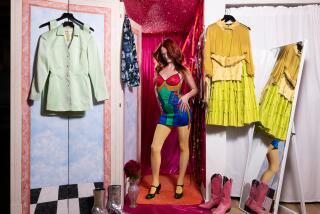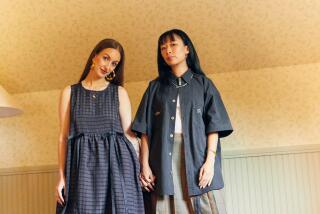The Long and Short of Jackets Over Skirts
- Share via
Question: I have a fitted suit in black-and-white checked wool--rough drawing enclosed. There’s nothing really wrong with it but I’m bored with it. Any ideas for changing this 1983 model into a 1986/7?--A.W.
Answer: Wear the jacket belted, over a full tweed skirt, just as Rome designer Valentino showed in his recent couture collection for fall. Then you can wear your narrow, knee-length checked skirt with a long, black tunic top. The new rule in pairing jackets and skirts is this: Short over long and long over short.
Q: I waited for a long time to realize my dream of owning a St. John knit. Now I realize I made a mistake in buying a short-sleeved dress. So many restaurants and theaters are so air-conditioned in the summer that my arms are always cold, and in the winter a short-sleeved dress just does not look right. What options do I have? Is it possible to send the dress back to St. John knits and have new sleeves put in? The dress is plain black. Or is there anywhere else I could have sleeves put in? Would it look right to use sleeves of a different color, such as white or ivory?--M.R.J.
A: Try taking the dress back to the store where you purchased it, and ask the buyer to intercede with the people of St. John knits. If you are not successful in getting long-sleeve replacements, take your dress to a dressmaker, and ask her to substitute long black suede sleeves or long black Ultrasuede sleeves. In other words, change the fabric but stay with the same color.
Q: Please comment on the wide variation in sizing between ready-made clothing and home-sewn clothing. Why the variations? I wear a Size 8 in ready-made clothes and a Size 12 in a pattern for home sewing. What gives?--G.F.
A: I took your question to Richard Segrin of Simplicity-owned Style patterns, who reports that the pattern companies got together about 30 years ago to standardize sizing in the industry. Their decisions were based on size statistics from the government’s Bureau of Standards. They still are. The only major sizing change during this period occurred in the ‘60s when bust-line measurements were lowered and waist measurements enlarged to reflect these changes in American women’s figures, Segrin reports.
Many of today’s pattern executives believe that hip measurements are too small for today’s woman, Segrin continues, explaining that it will take some time before all the pattern companies agree to set a date for putting such a change into effect. “For better or worse,” he says, “our pattern industry measurements are standard.
“A woman who sews knows that Size 12 patterns will fit specific measurements and that they do not change. Conversely, ready-to- wear manufacturers do not have standardized sizing. One company’s Size 6 is another company’s Size 8, and one company’s medium is another company’s small.
“Additionally, your size in ready-to-wear may also change because of the cut of a specific garment. A Size 12 can often wear a Size 8 coat if the proportions are full. A Size 2 can wear a smaller-size blouse if the shoulders are extended and the item’s look is oversize.
Q: Where can I buy patterns for square-dance dresses? For items like Hawaiian muumuus and sarongs? For Centennial costumes?--D.D.
A: Square-dance patterns are available at Jean Hardy Pattern Co., 2151 La Cuesta Dr., Santa Ana, Calif. 92705, and Authentic Patterns Inc., Box 4560 Stockyards Station, Fort Worth, Tex. 76106. Patterns for muumuus, sarongs, pareus and aloha shirts are available at Pauloa Patterns and Patterns Pacifica, both at Box 11254, Honolulu, Hawaii 96828. Pattern reproductions of clothes dating back to the 1880s are available at Past Patterns, 2017 Eastern St. S.E., Grand Rapids, Mich. 49507. Patterns for clothes from Edwardian England, Tibet, India, Croatia, China, Japan, Turkey, Romania, France, Nepal, Egypt and Syria are available at Folkwear Patterns, Box 3798, San Rafael, Calif. 94912.
Q: I am a senior citizen with shapely legs and thin ankles, but several dark veiny areas show through my hose. Can you recommend a good makeup to cover these blemishes?--A.M.
A: Opaque stockings and pantyhose are very much in fashion right now and will cover your problem without detracting from your shapely legs. If you’re still intent on a makeup, you might want to try a blemish cover-up recommended by a company that specializes in products for the handicapped and elderly. It’s called Perfect Leg Cover, and it’s a waterproof cosmetic that supposedly will not rub off or smear. Neither will it stain clothing, according to the people at FashionAble, 5 Crescent Ave., Box S, Rocky Hill, N.J. 08553. Two one-half-ounce containers are available in light, medium and dark for $5.






